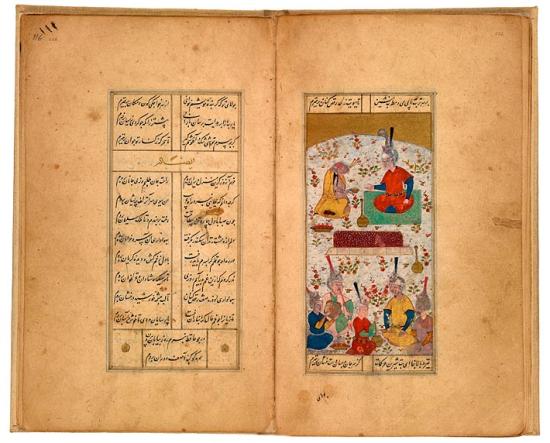
Gathering in a Graveyard
Dīvān (Poems), in Persian
Purchased by Pierpont Morgan before 1913
The author of his poem was known simply as Ḥāfiẓ, a name designating "one who knew the Qur˒an by heart." He was regarded as the greatest master of the Persian ghazal (love lyric) and his Dīvān remains popular to this day. Because of the sweetness of his poetry he was called Chagarlab (Sugar Lip). Here a convivial gathering, complete with wine and music, takes place in a cemetery. The low wooden cenotaph rests on a base of white marble. At the top of the page is the famous couplet:
Sit not at our tomb without wine and minstrel
That I may rise dancing from the grave at your aroma.
Persian poetry
The Persians loved their poetry and their poets, though the Qur˒an warned against believing their words (sura 69.41) and "those straying in evil who follow them" (sura 26.224). While Arabic was the first language of Islam and the language of the Qur˒an, Persian was favored by poets. Even Firdausī's (940–1020) celebrated Shāhnāma (Book of Kings), the national epic of Persian, was written in verse—some 50,000 couplets! Rūmī (1207–1273), the best known of the Sufi poets, put poetry in perspective when he wrote, "A hundred thousand books of poetry existed / Before the word of the illiterate [Prophet] they were put to shame!" (Masnavī I, 529). Presented here are illustrations of Firdausī's Shāhnāma as well as works by Sa˓ dī (ca.1184–1292), Hāfiz (ca. 1320–1389), and Jāmī (1414–1492), regarded as the last of the great Sufi poets. Also featured are illustrations from each of the five poems of the Khamsa (Quintet), by Niẓāmī (ca. 1141–1209), especially Lailā and Majnūn (The Persian Romeo and Juliet) and Bahrām Gūr's Seven Princesses.
